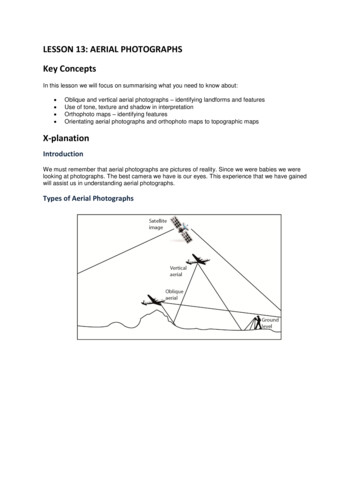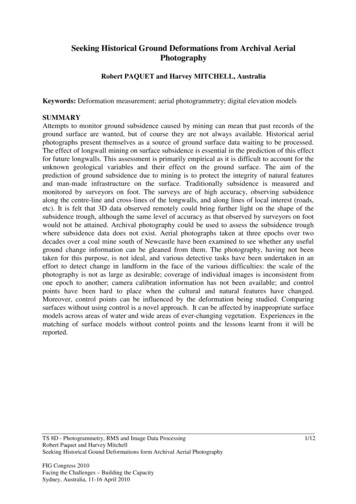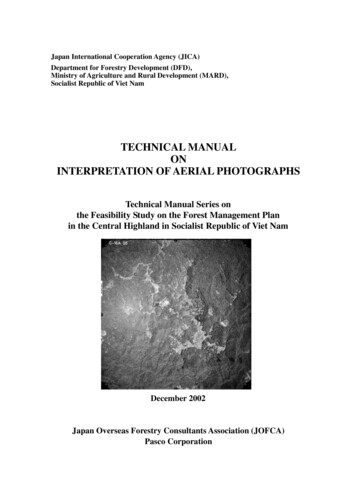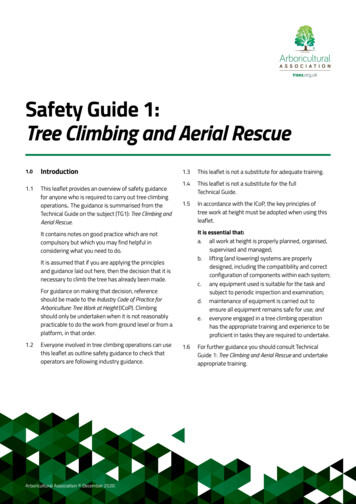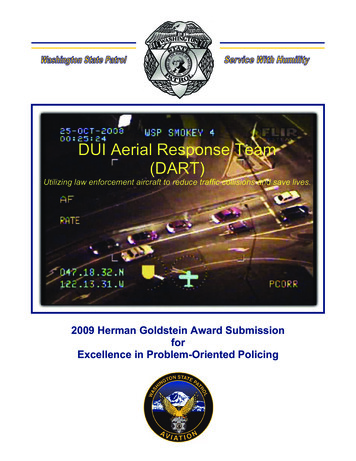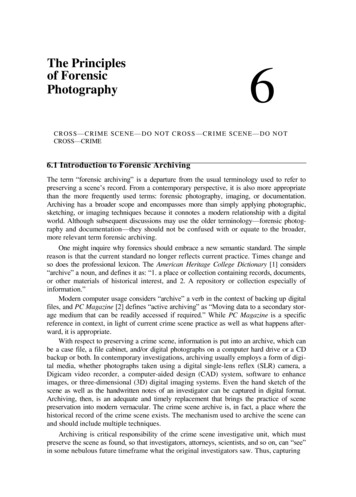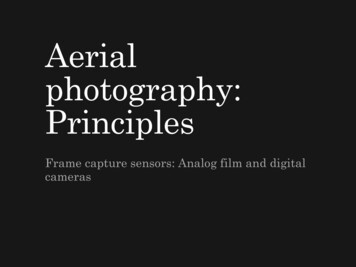
Transcription
Aerialphotography:PrinciplesFrame capture sensors: Analog film and digitalcameras
Introduction Frame vs scanning sensors Cameras (film and digital) Photogrammetry OrthophotosOverview
Air photos are collected using a frame-based sensor,while most other remote sensing products are obtainedusing a scanning or pushbroom sensor (e.g., LiDARuses a scanning approach).Frames versus scans
What is a significant benefit of frame-basedsensors over scanning sensors? Hint: geometryFrames versus scans
Every aerial mapping camerasuperimposes fiducial marks oneach photo. The fiducial markscan be used to determine theprincipal point ( ) of the photo, aswell as to determine if the photois distorted (compare the measureddistances between the fiducialmarks to the known distances).Aerial mapping camerasExample aerial photo specifications Go to page 17 Section 2-02.1
Colour film characteristics
Panchromatic film(black and white)Colour filmFilm spectral sensitivities
Colour film processing
Blue-absorbing filter is placed in front of the film (e.g., on the lens)Colour IR film characteristics
Colour IR film processing
When working with film we need to be concerned withits sensitivity - how little light (photons) is required toactivate the film’s crystals and what range of light canbe detected. The sensitivity is related to the speed ofthe film. The finer the crystal the ‘slower' the film.Larger grains are more sensitive with a biggerdynamic range, but larger grains result in lowerspatial resolution. Finer grains produce higherresolution, but with less sensitivity.Up to the equivalent of200 megapixels in an9 9” photographwith fine grain filmFilm sensitivity
10 MB pixel camera216 MB pixel camera, capturing bothpanchromatic and multispectral imagesDigital cameras
Panchromatic filmIR filmFilm characteristics
Panchromatic filmIR filmFilm characteristics
Natural colour filmIR colour filmFilm characteristics
Natural colour filmIR colour filmFilm characteristics
geometric propertiesabout objects are determined fromphotographic images. Photogrammetry isas old as modern photography and canbe dated to the mid-nineteenth century. Photogrammetry: Photogrammetryallows for theextraction of three-dimensional featuresfrom remotely sensed data (close-range,aerial, orbital, etc.).The science of photo geometry
The majority of aerial photos are taken forphotogrammetric purposes (e.g., to provideinformation to be used in the creation of a topographicmap).To meet those purposes, stereo aerial photographs arerequired.Obtaining aerial photos
How is it that we can use overlapping photos to view alandscape in 3-D?Stereo vision
Stereo photography
Obtaining stereo coverage
Photogrammetric control surveysProducing topographic maps
Very sophisticated devicesused to derive precise coordinate informationNow, most photogrammetric projectsare completed using softcopyphotogrammetric software.Stereoplotters
Topographic maps
Compare the map and photograph below. Both showthe same gas pipeline, which passes through hillyterrain. Note the deformation of the pipeline route inthe photo relative to the shape of the route on thetopographic map. The deformation in the photo iscaused by relief displacement. A single photo does notserve well as a source for topographic mapping.Air photo ‘distortions’
Relief displacement: the radial distance betweenwhere an object appears in an image versus where itshould be according to a planimetric coordinate system(the datum plane). Displacement is radially outwardfor features above the nadir elevation, and inward forfeatures below the nadir elevation (on the film plane).Relief displacementresults in the tops ofthe buildings to appearas if they were leaningoutwards from the centreof the photo.Air photo ‘distortions’
Relief displacement—asimple explanation. Consider point A. On a map (the‘datum plane’), A would appear atpoint A’ (orthographicallyprojected down from A). Aphotograph of the map wouldshow A’ at point a’. However, inthe actual photograph A shows upat point a”. Point a” is displacedoutward from point a’. Similarly, point B would appear atB’ on a map. On the photo point b’(the photographed ‘map’ positionof B) is further away from thenadir (represented as line N / n)than is point b” (the actualposition of B in the aerial photo--Bis displaced inward).Air photo ‘distortions’
Trying to fly the plane in a straight,level path is often difficult.YawNotice how the photosdon’t line up, and howthey are ‘twisted’ relativeto each other,which indicates that the planecould not fly in aperfect straight line.Air photo ‘distortions’
Orthophotos are created by (conceptually) draping theair photographs over a DEM, carefully mosaicing themtogether; removing the ‘distortions’ associated with theperspective projection, scale differences, etc. (i.e., byensuring that the scale is constant everywhere in thephoto).Orthophotos
Four basic operations or corrections must be appliedto the standard vertical aerial photograph to producean orthophoto: standardization of scale across the image (i.e., usea DEM to normalized the distance from the camerato the ‘ground’) removing the relief displacement to position theterrain in its true location. assignment of ground coordinate values (e.g., UTMeastings and northings) to the image. The final task involves the radiometric or tonaladjustments to allow the image to blend withneighboring images. (a complete example)Orthophoto Construction
Orthophotos provide the same view of the landscape(an orthographic one) as do maps.Aerial photosprovide aperspectiveview of theLandscape.OrthophotoOrthophotos
Orthophotos are metric photos; aerial photos are notmetric.The qualities of aerial photos that enable us to see stereo imagesmean that any single aerial photo presentsa non-metric view of the landscape.Orthophotos
A comparison of an aerial photo with anorthophoto. Note how the linear feature isdistorted in the aerial photo, but is straight (as itshould be) in the orthophoto.Orthophotos
Using stereoplotters (analogor digital [softcopy]) many‘layers’ of information can bederived from aerial photos;as well, if orthophotos areproduced the resultingimages can also be used in aGIS.Aerial photos GIS
Introduction Frame vs scanning sensors Cameras (film and digital) Photogrammetry OrthophotosSummary
Four basic operations or corrections must be applied to the standard vertical aerial photograph to produce an orthophoto: standardization of scale across the image (i.e., use a DEM to normalized the distance from the camera to the ‘ground’) removing the relief d
